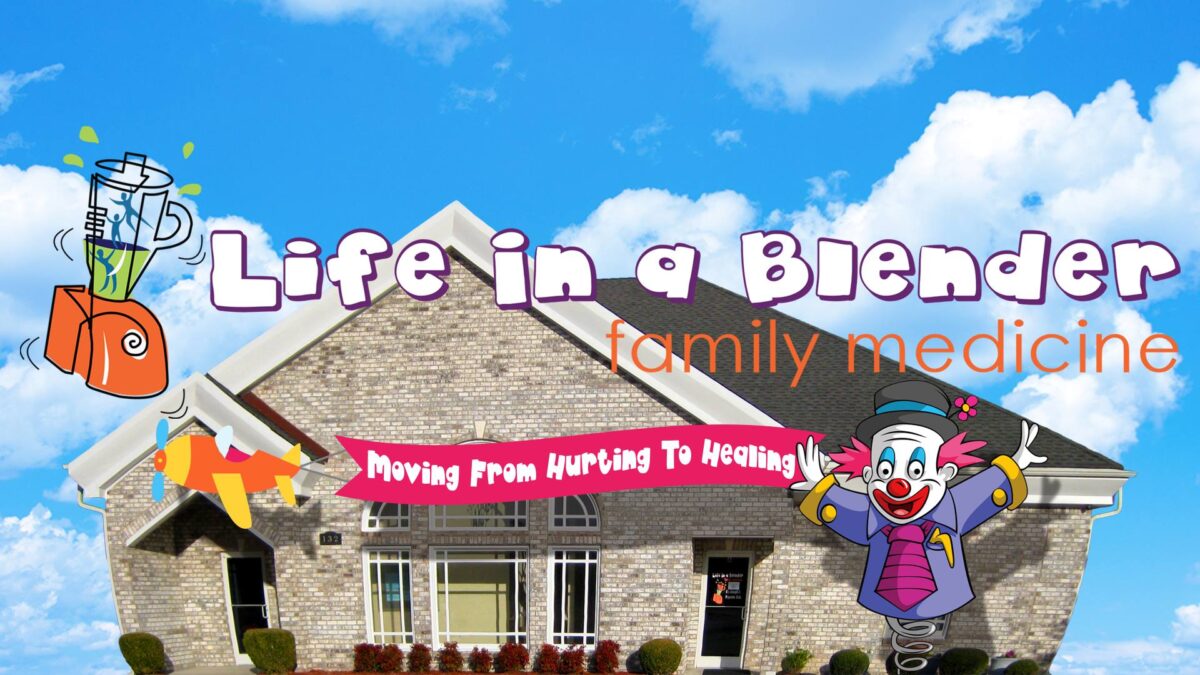Radio Health Chat #176
Welcome to josephpapotto.com, the official blog of Life in a Blender Family Medicine! I’m your host, Dr. Joe Papotto, and I’m excited to share with you a unique perspective on health and well-being through our radio show, Life in a Blender, Mind Bender, Radio Health Chat.
Our show covers a wide range of topics that impact your health, including new medical headlines, human interest stories, reviews of essential topics in medicine, and even exploring how the Bible meets science. But what sets us apart is our approach to medical care – we strive to treat people like humans, with compassion, good humor, and the “Care Factor”.
At Life in a Blender Family Medicine, we’re putting the “family” back in family medicine. We believe in dispensing medical care with an attitude of compassion and understanding, and our incredible and magical staff are dedicated to assisting you in obtaining the treasures of good health. We believe that people don’t care what you know until they know that you care, and we truly care about our patients.
In addition, I would like to express my heartfelt appreciation to my precious angel wife, Amy, who has been my unwavering support and the wing that enables me to soar onward and upward. We are all like angels with only one wing, and together, we can fly embracing each other.
So, join us on josephpapotto.com as we embark on this journey of exploring health and well-being with humor, wit, and wisdom. Together, let’s embrace a different kind of medical entertainment that focuses on what you really need to know to enhance your health and well-being. Stay tuned for our upcoming blog posts, and don’t forget to check out our radio show, Life in a Blender, Mind Bender, Radio Health Chat, on air or online. Thank you for being a part of our community, and let’s create a healthier, happier world together!
Title: Mind Excursion Slight Diversion: Weird, Wild, and Wonderful Facts
Today, we’re taking a mind excursion and diving into some weird, wild, and wonderful facts that will surely leave you intrigued. From cashew nuts to playing cards to camels, let’s explore some interesting tidbits that will make you say, “Ever Wonder Why???”
Have you ever noticed that you never see cashew nuts in their shells? It turns out that cashew shells contain a strong acid that can blister the skin. To make sure that all traces of the acid are removed, cashew nuts must be roasted. So, the next time you enjoy a handful of cashews, remember that they’ve gone through a process to ensure they’re safe to eat!
Now, let’s talk about playing cards. Did you know that the four suits we see in modern playing cards – hearts, spades, clubs, and diamonds – originated in France in the fourteenth century? It has been suggested that these four suits represent the four major classes of French society at that time. Hearts, shaped like a shield, represent the nobility and the church. Spades, shaped like a spear tip, represent the military. Clubs, shaped like clover, represent the rural peasant, and diamonds, shaped like the tiles associated with merchants’ shops, represent the middle class. So, the next time you play a game of cards, take a moment to appreciate the history and symbolism behind the suits!
Now, let’s move on to camels. Have you ever wondered why camels have humps? It’s not just for show – camels store fat in their humps! When camels cannot find food, they rely on the fat stored in their humps for energy. As the fat is used up, the hump shrinks, and in the case of the two-humped Bactrian camel, the tops of the humps flop over to one side. The humps regain their full shape once the camel eats again. In addition to serving as food storage bins, the fatty humps also provide insulation from the hot rays of the sun in the harsh desert environments where camels are found.
Isn’t it fascinating how nature has its own unique ways of adapting to different environments? These weird, wild, and wonderful facts remind us that there is always more to learn and discover about the world around us. So, take a moment to appreciate the little wonders and quirks that make our world so interesting and diverse.
Now, it’s your turn. What’s wild, wacky, sometimes wise, wonderful, and whimsical in your world today?
Welcome to Part 2 of our radio show, Life in a Blender, Mind Bender, Radio Health Chat, hosted by Dr. Joe Papotto. Today’s hot topic is hypertension (HTN), a common condition that affects millions of people worldwide. We’ll delve into the causes, risk factors, and categories of HTN, as well as discuss some interesting tangential thoughts, take a break from our usual programming to explore how to discover God’s will for your life, and share some other cool stuff, time permitting.
But first, a special announcement! We are excited to welcome “Charlie” Graham, a family nurse practitioner, to our clinical team here at Dr. Papotto’ s office. Charlie is known for her intelligence, skill, and caring demeanor, and she’s eager to meet new patients. Don’t hesitate to call and schedule your new patient appointment with Charlie today!
Now, let’s dive into our hot topic for today – hypertension, also known as high blood pressure. We received a request for this topic from Loraine, a long-time listener from The Sons of Italy Club in Socastee. HTN is a condition in which the long-term force of the blood against the artery walls is consistently high, potentially leading to health problems such as heart disease and stroke.
Blood pressure is determined by two factors: the amount of blood your heart pumps and the resistance to blood flow in your arteries. When your heart pumps more blood or when your arteries are narrow, your blood pressure tends to be higher. However, most people with HTN have no signs or symptoms, making it a silent yet dangerous condition. Some individuals may experience symptoms such as headache, shortness of breath, chest pain, and even nosebleeds or conjunctival hemorrhages when their blood pressure is elevated.
So, how do we define and categorize hypertension? Blood pressure readings are given in millimeters of mercury (mm Hg) and consist of two numbers – the systolic blood pressure (SBP) and the diastolic blood pressure (DBP). The SBP measures the pressure in your arteries when your heart is contracting, while the DBP measures the pressure when your heart is relaxing.
Here are the categories for blood pressure:
Normal blood pressure: SBP < 120 mm Hg and DBP < 80 mm Hg
Pre-hypertension: SBP 120-139 mm Hg or DBP 80-89 mm Hg
Stage 1 hypertension: SBP 140-159 mm Hg or DBP 90-99 mm Hg
Stage 2 hypertension: SBP ≥ 160 mm Hg or DBP ≥ 100 mm Hg
Both numbers are important, and the target goals for blood pressure may vary depending on age and other factors. For example, in individuals over 60 years of age, systolic hypertension is common due to arterial hardening, so the SBP goals may be more flexible in older adults.
What are the causes and risk factors of hypertension? While most adults with HTN have “essential hypertension,” which is primarily due to genetic predisposition, there are other potential causes and risk factors to consider. These may include:
- Obstructive sleep apnea (OSA)
- Kidney disease, such as renal artery stenosis (RAS) and adrenal gland tumors
- Thyroid problems
- Use of birth control pills (BCPs)
- Illegal drugs and alcohol abuse
- Aging
- Race, with African Americans being at higher risk.
- Obesity and lack of physical conditioning
- Tobacco use
- Low potassium intake in the diet
- Chronic stress
- Other chronic medical conditions, such as diabetes mellitus (DM)
Terrific Tangential Thought – Lobster: From Trash to Delicacy
Let’s take a dive into the history of lobster, which was not always the pricey delicacy it is today. It may surprise you to learn that in colonial America, lobsters were considered the “poor man’s protein” and even referred to as the “cockroach of the sea”. But how did lobster go from being a lowly food source to a fancy entree? Let’s explore the fascinating journey of lobster from trash to delicacy.
In Colonial America: Lobster, the “Poor Man’s Protein” In colonial America, lobsters were abundant and considered a cheap source of food. They were so plentiful that they were often fed to prisoners and servants, and having lobster shells in a house was even considered a sign of poverty. In fact, some servants made stipulations in their contracts to avoid being forced to eat lobster more than three times a week. Lobsters were not considered a delicacy, and their reputation was quite poor, earning them the nickname “cockroach of the sea”.
The Canning Industry and the Railroad: Changing Tides for Lobster The change in the perception of lobster started with the success of the canning industry in the 1840s. Canning allowed the demand for Maine lobster to be met in other areas of the East Coast, which led to increased availability and distribution of lobster. Additionally, the development of the railroad played a crucial role in changing the perception of lobster. Railways started serving lobster to passengers who were unaware of its previous reputation as a lowly food source. This exposure to lobster as an exotic item caused the demand for lobster to rise, leading to an increase in prices.
Lobster’s Changing Fortunes: From Exotic Item to Delicacy As demand for lobster increased, prices rose, and lobster started to be considered a delicacy again. By the 1920s, the price of lobster had reached its first peak, but the Great Depression caused a decline in its popularity once again. However, by the 1950s, lobster had regained its status as a delicacy, and it has remained a prized food item ever since.
Conclusion: The history of lobster is a fascinating tale of how perceptions and values around food can change over time. From being a cheap and abundant food source to becoming a luxury item, lobster’s journey from trash to delicacy is a remarkable story. So, the next time you enjoy a lobster platter at your favorite seafood restaurant, remember that lobster wasn’t always considered a pricey entree. It’s a great example of how our perception of food can evolve over time, and it’s a reminder to appreciate the value and history behind the foods we enjoy today.






